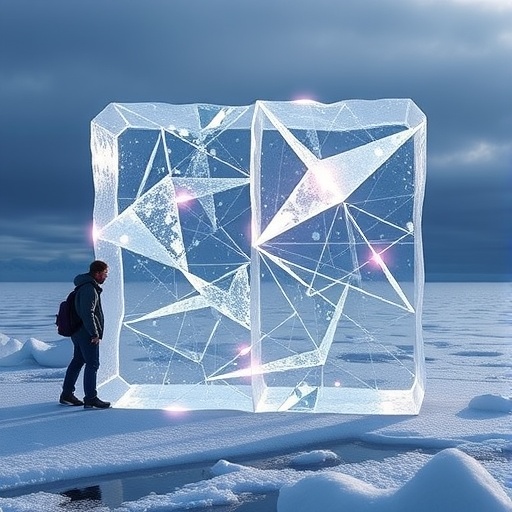
In a groundbreaking development that bridges the fields of physical chemistry, materials science, and information technology, researchers have unveiled an innovative approach to encoding messages within ice by precisely manipulating trapped air bubbles. Drawing inspiration from the natural formations of air bubbles in glaciers, this novel technique employs the controlled formation and arrangement of bubbles in frozen water to store data in binary and Morse code. This advancement heralds a new frontier in information storage, offering a low-energy, covert, and durable method to preserve short messages, particularly suited for the extreme and frigid environments of the Arctic and Antarctica where conventional storage solutions face significant challenges.
The cornerstone of this research hinges on the phenomenon of bubble formation during the freezing of water. As water transitions to ice, dissolved gases are expelled and compressed into microscopic pockets that form air bubbles. These bubbles can manifest in two primary morphologies: egg-shaped and needle-shaped. Their size, shape, and distribution within three-dimensional ice structures are intrinsically linked to the dynamics of the freezing process—especially the rate at which temperature decreases and the directional progression of the freeze. By exploiting these physical principles, the research team established a methodology to deliberately control bubble characteristics through meticulous manipulation of the freezing conditions.
To rigorously examine and harness the factors influencing bubble genesis, the investigators employed a custom cold plate apparatus. They confined a thin, two-dimensional layer of water between transparent plastic sheets, facilitating direct observation of bubble development. Systematic variation of temperature gradients and freeze rates allowed the team to decode the relationship between freezing kinetics and bubble morphology. Notably, an abrupt increase in the freezing rate—achieved via a sharp drop in cold plate temperature—resulted in the formation of a singular bubble layer dominated by uniformly shaped egg-like bubbles. Conversely, gradational changes to freezing velocity yielded stratified ice layers embedding an ordered sequence of bubble shapes and densities. This layering ranged from egg-shaped bubbles to mixed morphologies, progressing to needle-shaped bubbles, and culminating in clear, bubble-absent ice. Such spatial differentiation and manipulation are pivotal to encoding distinct symbolic information.
.adsslot_8Fe4TbyiDw{width:728px !important;height:90px !important;}
@media(max-width:1199px){ .adsslot_8Fe4TbyiDw{width:468px !important;height:60px !important;}
}
@media(max-width:767px){ .adsslot_8Fe4TbyiDw{width:320px !important;height:50px !important;}
}
ADVERTISEMENT
Central to this technique is the ability to translate physical bubble characteristics into symbolic codes interpretable by human and machine readers alike. The researchers defined a coding schema wherein bubble size, shape, and precise positioning corresponded to specific characters within binary and Morse code frameworks. The freezing process was then programmed to modulate rate and directional parameters, effectively “writing” messages into the ice matrix through the orchestrated placement of bubbles. This not only highlights the method’s versatility in storing information but underscores its potential as a medium for discreet communication in conditions where electronic or paper-based communication is impractical or compromised by environmental constraints.
Decoding the frozen messages involves photographing the ice sample and converting the image into grayscale. Since air bubbles reflect light differently than the ice matrix—appearing nearly white against darker gray, bubbleless ice—the visual contrast enables computational detection of bubble parameters. Leveraging image processing algorithms, the team trained a computer system to discern bubble positions and dimensions reliably. Subsequently, the software interpreted the decoded data under the established binary or Morse conventions, translating the frozen patterns back into legible alphanumeric text. This automated pipeline from ice formation to message retrieval underscores not only the feasibility but also the scalability potential of this data storage strategy.
Evaluating the comparative efficacy of encoding schemes, the researchers found that binary coding far outstripped Morse code in storage capacity, accommodating messages approximately ten times longer. This significant enhancement opens avenues toward more complex data representation in frozen media. It also reflects the advantages intrinsic to binary systems, including ease of error correction, standardization across digital platforms, and robustness in noisy signal conditions—in this case, the natural imperfections within ice.
Beyond its immediate utility in encoding messages, the implications of controlled bubble manipulation within ice extend broadly across material science and engineering disciplines. Since trapped air bubbles inherently weaken the mechanical integrity of ice, precisely patterned bubble lines could be harnessed to define predetermined fracture paths, effectively “perforating” ice sheets to facilitate controlled breaking or sculpting. This concept parallels the use of scoring in brittle materials such as glass or ceramics and could revolutionize how artists, engineers, or environmental scientists handle ice structures.
Delving further into potential industrial applications, the researchers highlight parallels with materials like metals, where bubble formation during processes such as smelting critically influences material properties. Understanding bubble nucleation and distribution principles in ice could inform analogous phenomena in less transparent substances like aluminum, enabling better control over microstructure and mechanical behaviors without directly imaging internal features. Additionally, in fields such as aviation and maritime transport, insights derived from bubble control might inform improved ice prevention or removal technologies, mitigating hazards associated with ice accretion on aircraft wings and ship hulls.
From an aesthetic and commercial perspective, the ability to tailor ice bubble content through controlled freezing affords exciting opportunities in crafting intricate ice sculptures with varying levels of translucence and texture. By exploiting shape and density gradients, artists could produce visually stunning frozen artworks with embedded messages or distinctive light-reflecting effects, pushing the creative boundaries of ice artistry.
Looking ahead, the research team plans to expand their investigation to encompass the roles that gas type and concentration play in bubble characteristics within ice. The current work assumes primarily ambient atmospheric gases, but varying gas compositions could modulate bubble morphology, growth kinetics, and stability. Additionally, future studies aim to transition from two-dimensional to three-dimensional heat flux control, thereby enabling more complex and voluminous message embedding within larger ice monoliths. Such advancements could transform ice into a transient, renewable medium for information storage in polar research stations, remote outposts, or as a tactical resource in covert communications.
This innovative method’s capacity to offer energy-efficient, secure, and durable message storage in naturally cold environments is particularly noteworthy given the increasing challenges faced in polar regions regarding data transmission and preservation. Traditional electronics often require substantial power and infrastructure, while paper or other physical media suffer from degradation under extreme conditions. Ice messaging circumvents these hurdles by integrating data directly into the environmental medium, leveraging naturally low temperatures to maintain stability over extended durations.
The confluence of physics, materials engineering, and computer vision embodied in this work exemplifies a growing interdisciplinary approach to tackling contemporary challenges. By drawing on natural phenomena such as glacier bubble formation and enhancing them with precision-controlled experimental methods and computational decoding, the researchers have opened a novel channel for both fundamental science and practical innovation. This concept challenges conventional paradigms of information technology, suggesting a future where messages might be hidden, stored, and retrieved from the icy facets of our planet itself.
As climate change continues to impact polar environments, the ability to store critical environmental data or communications securely on site without reliance on electronic systems could become a vital asset. Moreover, the symbolic resonance of inscribing human messages into the ice connects scientific inquiry with cultural and historical narratives, evoking the dialog between humanity and the natural world. This research stands at that intersection, marrying scientific rigor with creative ingenuity and practical application.
In sum, the manipulation of trapped air bubbles in ice heralds a transformative approach to low-energy, covert data storage. Whether for scientific monitoring, secure communications in remote regions, industrial applications, or artistic expression, this technology offers a compelling glimpse into how understanding and controlling fundamental physical processes can unlock new capabilities in seemingly familiar materials. The future directions outlined by the research team promise to deepen this mastery, paving the way for increasingly sophisticated uses of ice as a medium for information and innovation.
Subject of Research: Not applicable
Article Title: Manipulating trapped air bubbles in ice for message storage in cold regions
News Publication Date: 18-Jun-2025
Web References:
https://www.cell.com/cell-reports-physical-science/fulltext/S2666-3864(25)00221-8
DOI: 10.1016/j.xcrp.2025.102622
Keywords
Ice, Gas separation, Data storage
Tags: air bubbles in frozen waterArctic and Antarctic research innovationsbubble formation dynamicscovert message encodingdata preservation techniquesencoding messages in iceinformation storage in extreme environmentsinnovative communication methods.low-energy data storage solutionsmaterials science in information technologyMorse code in icephysical chemistry of ice


